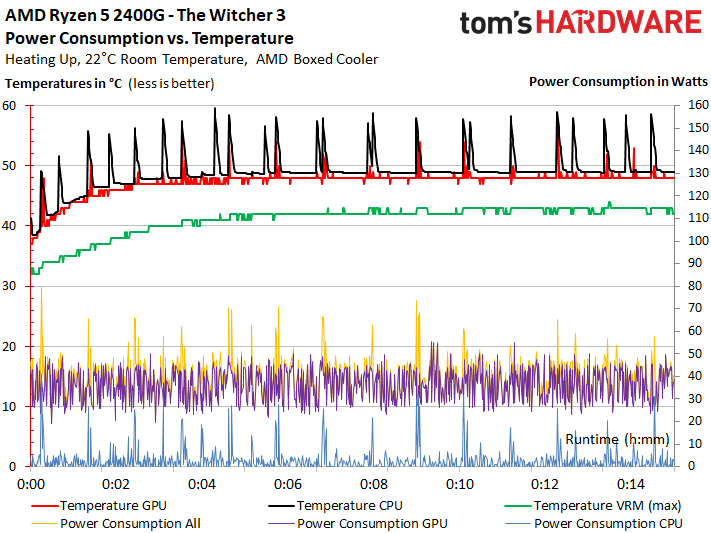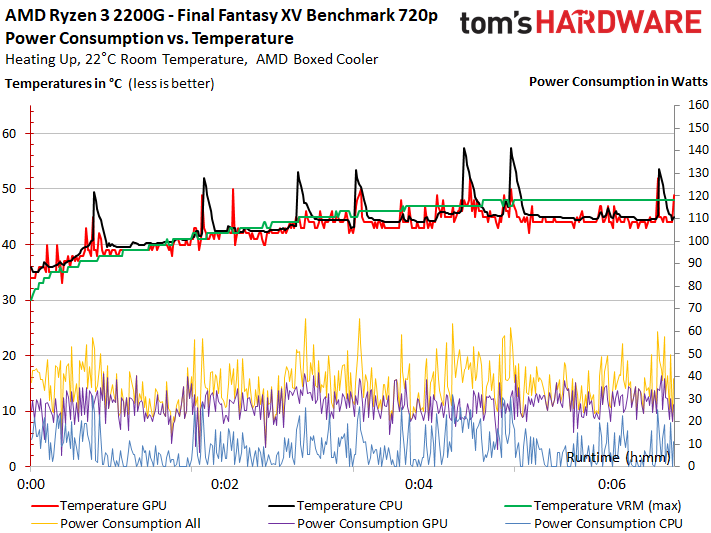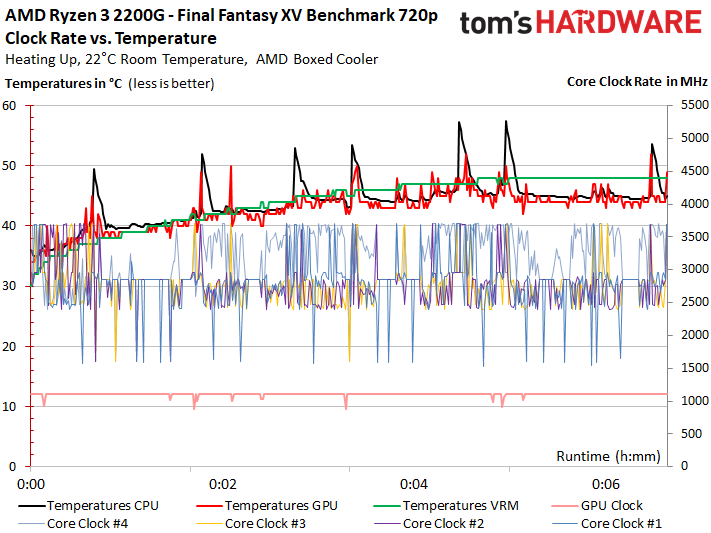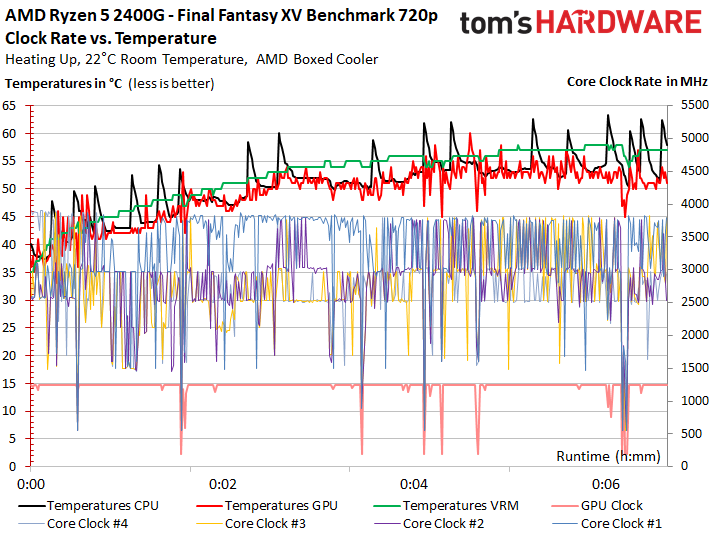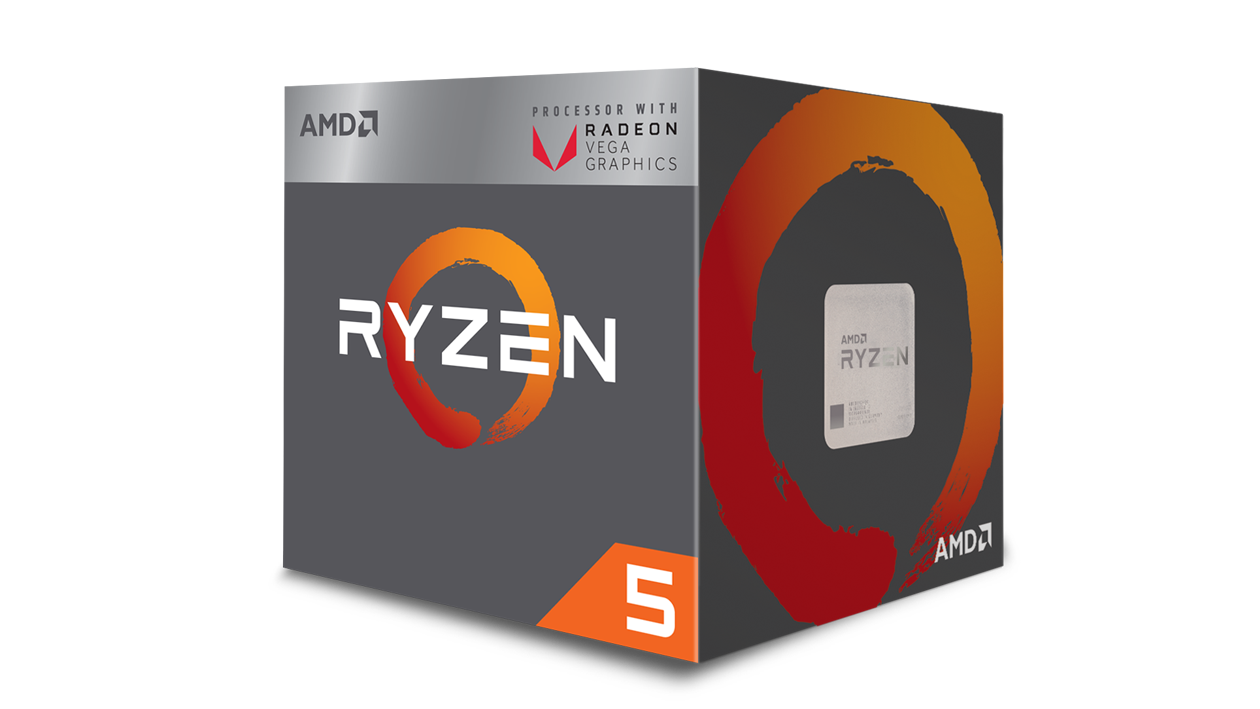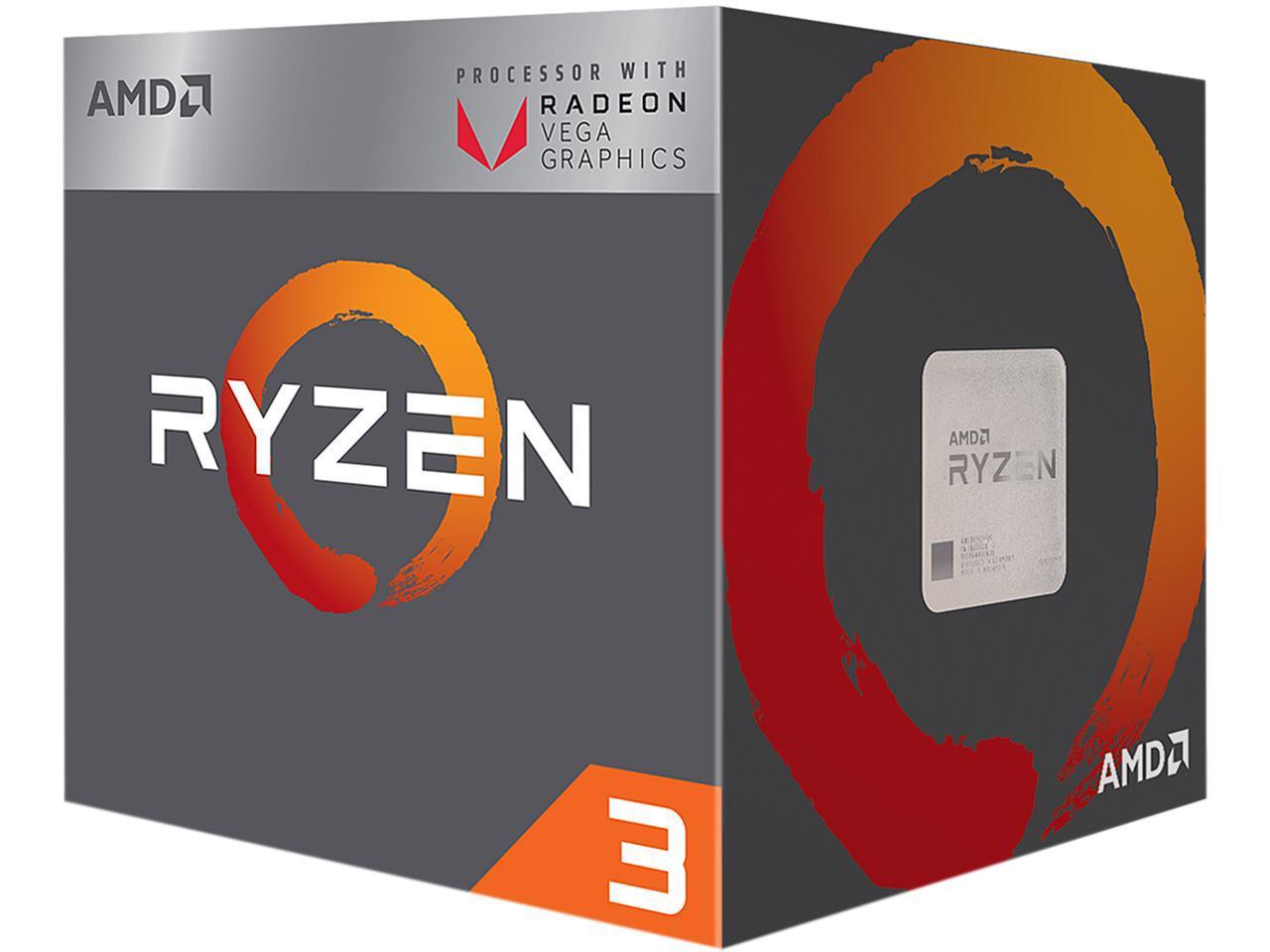AMD Raven Ridge Thermal/Power Analysis: Ryzen CPUs With Vega
Gaming: Benchmarks & Results
The Witcher 3 (Skellige)
The Witcher 3 is our go-to title for power consumption measurements because it almost always ends up generating results in line with manufacturer-defined power limits. The Skellige map produces the highest GPU and voltage converter loads that this game offers, so that's what we use. Host processing loads are somewhat below-average, though, especially since this title doesn't scale well with increasing core counts.
AMD Ryzen 3 2200G
The smaller of AMD’s two Raven Ridge-based processors averages 32W across our 15-minute run, including spikes as high as 62W. Performance ranges from 34 to 43 FPS, depending on the scene, showing this to be an efficient chip. Processor temperatures peak at 44°C, while the voltage converters make it all the way to 48°C. Really, both are good results.
An average clock rate of 2.86 GHz lands far below the 2200G's base frequency, meaning there's still headroom to spare. The same can’t be said for AMD's on-die graphics engine, which operates at its 1100 MHz ceiling almost the entire time.
AMD Ryzen 5 2400G
Not surprisingly, Ryzen 5 2400G is faster, but also more power-hungry. Its 40W average and 85W peaks are significantly higher than what we saw from Ryzen 3 2200G. In exchange, though, it offers frame rates between 38 to 50.
The 2400G's Zen cores operate at higher frequencies, though their rate over time is a bit erratic. Meanwhile, the Vega-based graphics engine stays at an almost-constant 1240 MHz.
Get Tom's Hardware's best news and in-depth reviews, straight to your inbox.
We do measure higher temperatures, but they remain under 50°C using AMD's stock cooler. Its fan isn't obtrusively loud by any means.
Final Fantasy XV’s Benchmark
Final Fantasy XV’s stand-alone benchmark won’t get a permanent spot in our suite, but it’s a great choice for testing at 1280x720 using the lowest preset with Nvidia’s HairWorks turned off. The reason we're using it is that Final Fantasy does apply a substantial CPU load. In stark contrast to The Witcher 3, this game actually utilizes the cores we throw at it.
AMD Ryzen 3 2200G
Ryzen 3 2200G, with its four Zen cores and 512 Stream processors, runs out of steam quickly. Its 24 to 30 FPS simply aren’t playable.
The benchmark run’s average power consumption increases to 37W, and the peaks rise to 67W. Our average temperature measurements hit just over 45°C for the processor and ~48°C for the voltage converters. Still, none of those numbers are cause for concern.
The CPU clock rate oscillates between an average of ~2.8 GHz and a maximum of 3.6 GHz. Again, the graphics engine is pegged at its 1100 MHz ceiling throughout almost all of our benchmark run.
AMD Ryzen 5 2400G
Just because the Ryzen 5 2400G is faster doesn't mean it's fast. Frame rates between 26 to 36 fluctuate quite a bit; we believe this is due to relatively slow DDR4 memory shared by the CPU and GPU.
Our average temperature measurement is now up to 54°C, while the voltage converters reach 58°C. Still, though, those results aren't cause for concern. AMD’s Wraith Stealth thermal solution is up to the task, so long as you're running normal workloads and not overclocking.
The CPU bounces around between ~3 GHz and 3.7 GHz, while the GPU sticks at an almost-constant 1240 MHz. The visible drops almost always hit the host and graphics processing blocks simultaneously, making it look like the skipping is caused by scene transitions or loading of some sort.
In the end, AMD's Ryzen 5 2400G fares well enough at 720p. Of course, as we saw yesterday, even 1080p is attainable if you dial down the details far enough. Older titles like Need for Speed: Underground 2 and GTA: San Andreas run smoothly at 1920x1080, even with anti-aliasing enabled!
Losing simultaneous multi-threading and three Compute Units makes the Ryzen 3 2200G an inferior choice, despite its lower price tag. If you aren't up for overclocking, reserve that one for office machines and simpler HTPCs tasked with video playback (and not gaming).
MORE: Best CPUs
MORE: Intel & AMD Processor Hierarchy
MORE: All CPUs Content
Current page: Gaming: Benchmarks & Results
Prev Page Introduction & Test System Next Page CPU & GPU Stress Testing: Benchmarks & Results
Igor Wallossek wrote a wide variety of hardware articles for Tom's Hardware, with a strong focus on technical analysis and in-depth reviews. His contributions have spanned a broad spectrum of PC components, including GPUs, CPUs, workstations, and PC builds. His insightful articles provide readers with detailed knowledge to make informed decisions in the ever-evolving tech landscape
-
Combat_Medic The prices you chose to use here are bogus - the $99 and $169 MSRP are what they're actually going for.Reply -
AgentLozen ReplyCombat_Medic said:The prices you chose to use here are bogus - the $99 and $169 MSRP are what they're actually going for.
The prices from Amazon or NewEgg (or whatever) are usually inaccurate. I think Tom's should provide us with the MSRP and the internet price. That way, if the internet price is malfunctioning and showing a +50% markup, at least we know what it's SUPPOSED to sell for.
edit: minor fix -
FormatC When I wrote this review, we had only the official MSRP from AMD. The availability in Germany looks ok and the prices in EUR with VAT are lower :)Reply -
Ninjawithagun The prices (provided via direct link to Amazon.com) are now correct. Unfortunately, they are all sold out...lol.Reply -
JamesSneed These seem to be very efficient for the CPU and GPU performance they deliver. Nifty more options for budget PC's.Reply
I am left wondering if the 14nm process AMD is using, is having issues scaling to higher frequencies as it appears you keep Zen and Vega at lower clocks and they are very efficient. -
FormatC I really like the new power management and it is finally nothing else as efficiency-orientated mobile technology for the desktop.Reply -
nuclearpowerofattorney Maybe the 2400G is so smart and powerful, that when it reaches critical computational capacity, it evolves to become sentient, and thus unruly. Only after it is rebooted, to have the sentience removed, will the system cease its rebellious behavior. (Actually, I don't think this..but it's all I've got).Reply -
Rookie_MIB For the 2400G, bundling the better Wraith Spire could probably avoid the throttling bouncing around by preventing it from hitting the thermal limits under the more taxing loads.Reply
Eventually though they're going to have to find out what's causing it to get stuck in that loop. -
7angrytangerines Obviously 2400G wants to protect itself from some poor saps trying to use it for cryptocurrency mining.Reply


